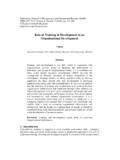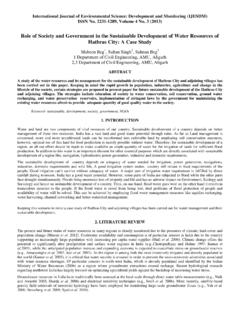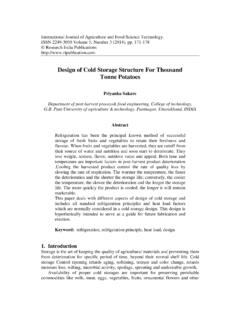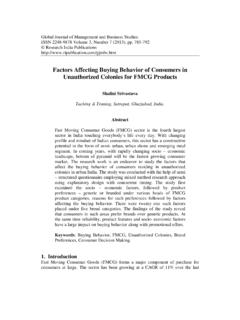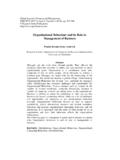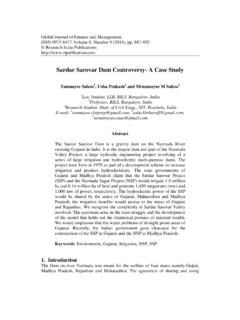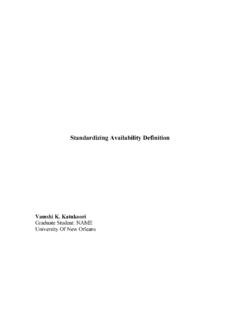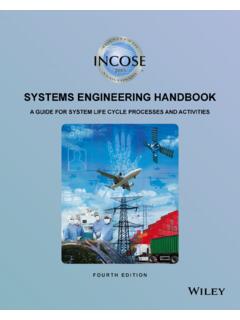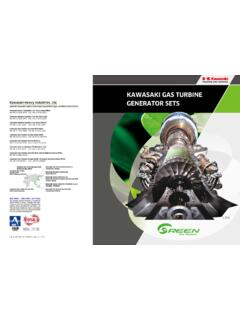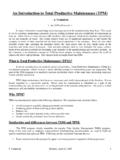Transcription of Analysis on Costs for Aircraft Maintenance
1 Advances in Aerospace Science and Applications. ISSN 2277-3223 Volume 3, Number 3 (2013), pp. 177-182 Research India Publications Analysis on Costs for Aircraft Maintenance U. PeriyarSelvam, T. Tamilselvan, S. Thilakan and M. Shanmugaraja Department of Aeronautical Engineering, Park College of Technology, Karumathampatti, Coimbatore 641 659. Abstract The underpinning of Aircraft Maintenance is to provide a fully serviceable flight when it is required by an airline at minimum cost . Maintenance Costs typically account for 10-20 per cent of Aircraft related operating Costs in which direct Maintenance cost is a significant contribution to operation of an Aircraft . Direct Maintenance cost refers the labor and material Costs directly associated in performing Maintenance . The present day market scenario posses hurdles to Aircraft Maintenance agencies to face thrust to minimize their cost of operation.
2 The intention of this paper is to identify methods to analyze and reduce direct Maintenance Costs . The factors influences the direct Maintenance cost are addressed in this paper. Minimizing the cost and maximizing the availability of Aircraft are the design factors considered as primarily in this paper. This paper analyzes the key factors for direct Maintenance cost and then discusses about methods to reduce direct Maintenance cost . A concept called reliability and Maintenance design is proposed in this paper. The inheritance of the proposed idea shows the positive signal to reduce direct Maintenance cost and to improve the inborn reliability of the Aircraft . Keywords: Aircraft Maintenance , Direct Maintenance cost , Environmental Factors, Design Factors, reliability and Maintenance Design.
3 1. Introduction Aircraft Maintenance activities form an essential part of airworthiness. Aircraft Maintenance is actions that can restore an item to a serviceable condition, and consist of servicing, repair, modification, overhaul, inspection and determination of condition. The common goal of Maintenance is to provide a fully serviceable Aircraft when it is required by an airline at minimum cost . For the present, Maintenance Costs of S. Thilakan et al 178commercial Aircraft make a significant contribution to an Aircraft s cost of ownership. Maintenance Costs typically account for 10-20 per cent of Aircraft related operating Costs . Direct Maintenance cost (DMC) is one of the major constituent of Maintenance cost which refers labour and material Costs directly expended in performing Maintenance of an Aircraft or related equipment.
4 The aim of this paper is to find out some methods to reduce DMC for commercial Aircraft . In the continuation, the paper first analyzes the key factors that influence DMC, and then discusses some methods that could reduce DMC, and finally draws a conclusion. 2. Factors influencing DMC The factors that influence DMC are categorized as design factors and environmental factors. About 70-85 per cent of a commercial Aircraft life Costs are determined during the design stage. The design of an Aircraft depends on many factors such as customer and manufacturer demand, safety protocols, physical and economic constraints etc. Minimizing the cost to support an Aircraft and maximizing the availability of that Aircraft are best done by designing the product to be reliable and maintainable. reliability (R) and maintainability (M) are intrinsic properties of an Aircraft .
5 Current system designs experience a 40 per cent, or higher, equipment false removal rate as a result of ambiguous and labour intensive test procedures. The increasing complexity of systems and technology adds to the difficulty of effective and timely fault diagnosis, thus contributing to the problems of system maintainability . Moreover, ineffective fault diagnosis can be expensive in terms of down time and cost , with no fault found (NFF) situations contributing significantly to Maintenance Costs . Fleet size and commonality, Aircraft age and utilization, maintain standard and plan, frequency of check intervals, level of subcontracting, accounting method, currency fluctuations over time, local labour rates, and the ratio of rotables to consumables and material prices are some of other organization-related variables influencing the DMC of an Aircraft .
6 3. Literature Review Wu et. al suggested some methods to cut down on direct operating Costs for commercial aircrafts. The key role in these suggested methods is the design and the diagnosis of the malfunction. Similarly, Boeing 777 is claimed to have relatively lower direct operating Costs than it s similar since its design is based on the principle mentioned by Wu et. al. 4. Concepts reliability and Maintenance Design (R&M) Approach R&M design approach works on the basis of following concepts; Meantime Between Failures (MTBF) MTBF says that random failures are unavoidable throughout the equipment life, and leads to much unscheduled Maintenance to be performed in routine of Analysis on Costs for Aircraft Maintenance 179 airline. The unscheduled Maintenance tends to be most expensive in terms of Maintenance Costs because it is unplanned.
7 Maintenance free operating period (MFOP) In order to reduce the Costs , a new method based on Maintenance free operating period (MFOP) has been developed. MFOP is defined as a period of operation during which the equipment must be able to carry out all its assigned missions without any Maintenance action and without the operator being restricted in any way due to system faults or limitations. During MFOP, the necessity for any Maintenance should be, by design, kept to a minimum. And the equipment is allowed to carry out only some planned minimal Maintenance , such as flight servicing. Maintenance recovery period (MRP) A Maintenance recovery period (MRP) follows immediately after a is defined as the down time during which appropriate scheduled or corrective Maintenance is done to recover the system to its fully serviceable state so that it is capable of achieving the next MFOP.
8 Not all MRPs will be of the same duration because they need to encompass different Maintenance activities for individual line replaceable unit (LRU), such as those that are life-expired those that require some overhaul and prevent Maintenance or just inspection. Additionally, there will be corrective Maintenance to be done to restore the full capability of those faulty systems Maintenance free operating period survivability (MFOPS) MFOPS is an extension of warranty period. The operators are considering extending this concept throughout the life of the system. The contractor/manufacture will be expected to guarantee that no unscheduled Maintenance activities will be required during each defined period operation with the predefined level of confidence.
9 The confidence is scaled by Maintenance free operating period survivability (MFOPS).MFOPS is defined as the probability that the item will survive for the duration of the MFOP. 5. Strides to Reduce DMC There are two strides to reduce direct Maintenance cost (DMC). Improvement in inherent reliability To achieve an optimum Maintenance plan. Higher reliability will decrease the number of failures and therefore, the man-hours and material necessary to fix them, so DMC will be brought down. To achieve MFOPs of Aircraft , it means that random failure should be eradicated during MFOP. The traditional culture, which believes that not only failures are unavoidable but also that are acceptable in a way, should be discarded. Many technique or solutions will be applied to design for reliability in a more proactive way, so that failure mechanism is S.
10 Thilakan et al 180not given the opportunity to occur. The techniques could range from a change in physical design, selecting a different component, an improved build process, or a more radical design change. To achieve an optimum Maintenance plan, the overall system of Aircraft will need some Maintenance actions at some point, but these will be performed during the planned MRPs. The MFOP defers virtually all corrective Maintenance to MRP, so the unscheduled element of Maintenance is exchanged for more scheduled Maintenance , based on the general improvement of reliability associated with more inherently reliable equipment. A more practical, cost -effective and balanced set of MRPs that build-up and support the best overall system MFOP, can be achieved by means of trade-off and methodology for system engineering during design.
